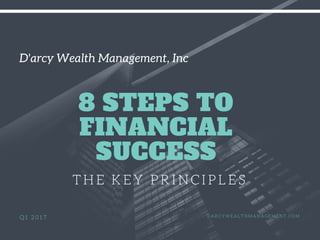
8 Steps to Financial Success
- 1. D'arcy Wealth Management, Inc 8 STEPS TO FINANCIAL SUCCESS THE KEY PRINCIPLES Q1 2017 DARCYWEALTHMANAGEMENT.COM
- 2. STEP 1 – SET YOUR GOALS Not setting goals makes it difficult to chart your progress. Work backwards if necessary. If you want a certain sum in a certain number of years, you can find out what it is going to take to get you there. How to reach $1,000,000 from scratch To see how much you need to invest on a monthly basis to reach $1,00,000 at age 65, see the table below (not adjusted for taxes). This chart assumes a 6% annual rate of return, used for illustration purposes only, and is not intended to represent the performance of any particular product.
- 3. STEP 2 – UNDERSTAND RISK Historically stocks have significantly outperformed other investments in the long-run. Even though the prevailing bull market of the last decade has demonstrated higher than normal returns, equity-oriented investments have historically out paid other investments
- 4. STEP 3 – TIME IS ON YOUR SIDE Understanding the power of compounding returns will help you understand how saving a little now can produce a substantial sum of money down the road. RULE OF 72 The Rule of 72 is a formula to approximate how many years it will take to double your money given a specific compounded annual rate of return. For example, if you invest a lump sum of money and receive a compounded annual rate of return of 10%, it will take you 7.2 years to double your money. Taxes are not taken into consideration. 72 / 10 = 7.2 years The following is a table of compounded annual rates of return, and the corresponding years it will take to double your money. This is a hypothetical example used for illustrative purposes only and is not intended to represent the performance of any particular product. Rate of Return Years to Double your money 3% 24 6% 12 9% 8 12% 6
- 5. STEP 4 - INVEST EARLY, INVEST OFTEN Waiting for an employer to fund your retirement, or putting it off until “later’ is the mistake most investors make when it comes to funding investments. Employ the “percentage solution” by putting away a certain percent of your monthly gross income towards investments before anything else. Available money always seems to find a place to get spent, so get it invested before you have a chance to spend it. Invest early and invest often. The earlier you start as an investor, the bigger the bang you get for your investing bucks. It’s all about compounding, a term that means earning investment gains on your investment gains. If you invest $1,000 and make 10% in the first year, then going forward you have $1,100 working for you. The longer you stay invested, the better compounding works. If you invest $1,000 and make 5% annually over 20 years, you end up with $2,653. Above is a hypothetical example used for illustrative purposes only and is not intended to represent the performance of any particular product.
- 6. STEP 5 – INCREASE YOUR SAVINGS WHENEVER YOU CAN Inflation will not stop for you, so don’t forget to increase your savings when your income increases.
- 7. STEP 6 – STAY FOCUSED Don’t try to time the market. The trick is “time in” the market. When interest rates are low, stocks tend to grow. Invest for the long term when possible, keep your short term or “emergency money” in safe accounts. Even the results of successfully timing the market are relatively insignificant in the long-run. Hypothetically, if $10,000 is invested each year for 20 years in the S&P 500 Index on the worst day of each year (market at its highest), systematically (regardless of the market), and the best day of each year (market at its lowest), how will each investment account do? Again, the result demonstrates that when you put money in doesn’t matter as much as how long it is in— invest anytime, but stay invested. Worst-day Investments (Market Highs)
- 10. STEP 7 – HAVE ADEQUATE LIFE INSURANCE A good rule of thumb is to have a minimum of 10 times your annual income. That amount, properly invested, should be able to replace the annual income lost in the event of death. For a non-working spouse, it is still important to consider coverage, especially if they are providing care for your children. STEP 8 – USE D’ARCY WEALTH MANAGEMENT As a D’Arcy Wealth Management client, you have access to a professional wealth manager. Professional wealth managers offer... Experience Wealth Managers bring wisdom and knowledge gained from years serving client needs and goals as investment professionals. Time Wealth Managers stay on top of the investment world so you don’t have to. Resources Wealth Managers are backed by the research, expertise, and additional support of the professional investment company. Knowledge Wealth Managers understand how different products work within different strategies. Investment Planning Wealth Managers help you determine your investment goals and risk tolerance. Investment Discipline Wealth Managers remind you of your investment goals and help evaluate various moves based on those goals. Taxes Wealth Managers can help provide information about the tax consequences of different investment products and different investment moves. D’Arcy Wealth Management is a leading provider of investment and insurance products. Whether you need stocks, bonds, mutual funds, ETFs, annuities, life insurance, or estate planning products, D’Arcy Wealth can help you reach your financial goals. Contact us today and speak with a Wealth Manager darcywealth@gmail - general email 909.754.1570 - office
